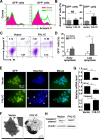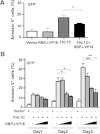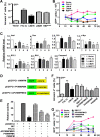FHL1C induces apoptosis in Notch1-dependent T-ALL cells through an interaction with RBP-J
- PMID: 24952875
- PMCID: PMC4077834
- DOI: 10.1186/1471-2407-14-463
FHL1C induces apoptosis in Notch1-dependent T-ALL cells through an interaction with RBP-J
Abstract
Background: Aberrantly activated Notch signaling has been found in more than 50% of patients with T-cell acute lymphoblastic leukemia (T-ALL). Current strategies that employ γ-secretase inhibitors (GSIs) to target Notch activation have not been successful. Many limitations, such as non-Notch specificity, dose-limiting gastrointestinal toxicity and GSI resistance, have prompted an urgent need for more effective Notch signaling inhibitors for T-ALL treatment. Human four-and-a-half LIM domain protein 1C (FHL1C) (KyoT2 in mice) has been demonstrated to suppress Notch activation in vitro, suggesting that FHL1C may be new candidate target in T-ALL therapy. However, the role of FHL1C in T-ALL cells remained unclear.
Methods: Using RT-PCR, we amplified full-length human FHL1C, and constructed full-length and various truncated forms of FHL1C. Using cell transfection, flow cytometry, transmission electron microscope, real-time RT-PCR, and Western blotting, we found that overexpression of FHL1C induced apoptosis of Jurkat cells. By using a reporter assay and Annexin-V staining, the minimal functional sequence of FHL1C inhibiting RBP-J-mediated Notch transactivation and inducing cell apoptosis was identified. Using real-time PCR and Western blotting, we explored the possible molecular mechanism of FHL1C-induced apoptosis. All data were statistically analyzed with the SPSS version 12.0 software.
Results: In Jurkat cells derived from a Notch1-associated T-ALL cell line insensitive to GSI treatment, we observed that overexpression of FHL1C, which is down-regulated in T-ALL patients, strongly induced apoptosis. Furthermore, we verified that FHL1C-induced apoptosis depended on the RBP-J-binding motif at the C-terminus of FHL1C. Using various truncated forms of FHL1C, we found that the RBP-J-binding motif of FHL1C had almost the same effect as full-length FHL1C on the induction of apoptosis, suggesting that the minimal functional sequence in the RBP-J-binding motif of FHL1C might be a new drug candidate for T-ALL treatment. We also explored the molecular mechanism of FHL1C overexpression-induced apoptosis, which suppressed downstream target genes such as Hes1 and c-Myc and key signaling pathways such as PI3K/AKT and NF-κB of Notch signaling involved in T-ALL progression.
Conclusions: Our study has revealed that FHL1C overexpression induces Jurkat cell apoptosis. This finding may provide new insights in designing new Notch inhibitors based on FHL1C to treat T-ALL.
Figures






Similar articles
-
The LIM domain protein FHL1C interacts with tight junction protein ZO-1 contributing to the epithelial-mesenchymal transition (EMT) of a breast adenocarcinoma cell line.Gene. 2014 Jun 1;542(2):182-9. doi: 10.1016/j.gene.2014.03.036. Epub 2014 Mar 19. Gene. 2014. PMID: 24657059
-
Structure and function of the CSL-KyoT2 corepressor complex: a negative regulator of Notch signaling.Structure. 2014 Jan 7;22(1):70-81. doi: 10.1016/j.str.2013.10.010. Epub 2013 Nov 27. Structure. 2014. PMID: 24290140 Free PMC article.
-
RING1 inhibits transactivation of RBP-J by Notch through interaction with LIM protein KyoT2.Nucleic Acids Res. 2004 Mar 3;32(4):1492-501. doi: 10.1093/nar/gkh295. Print 2004. Nucleic Acids Res. 2004. PMID: 14999091 Free PMC article.
-
New insights into Notch1 regulation of the PI3K-AKT-mTOR1 signaling axis: targeted therapy of γ-secretase inhibitor resistant T-cell acute lymphoblastic leukemia.Cell Signal. 2014 Jan;26(1):149-61. doi: 10.1016/j.cellsig.2013.09.021. Epub 2013 Oct 16. Cell Signal. 2014. PMID: 24140475 Review.
-
Therapeutic targeting of NOTCH1 signaling in T-cell acute lymphoblastic leukemia.Clin Lymphoma Myeloma. 2009;9 Suppl 3(Suppl 3):S205-10. doi: 10.3816/CLM.2009.s.013. Clin Lymphoma Myeloma. 2009. PMID: 19778842 Free PMC article. Review.
Cited by
-
Role of four and a half LIM domain protein 1 in tumors (Review).Oncol Lett. 2024 Oct 29;29(1):37. doi: 10.3892/ol.2024.14783. eCollection 2025 Jan. Oncol Lett. 2024. PMID: 39512507 Free PMC article. Review.
-
Canonical and noncanonical NOTCH signaling in the nongenetic resistance of cancer: distinct and concerted control.Front Med. 2025 Feb;19(1):23-52. doi: 10.1007/s11684-024-1107-1. Epub 2025 Jan 2. Front Med. 2025. PMID: 39745621 Review.
-
Role of Autophagy and Apoptosis in Acute Lymphoblastic Leukemia.Cancer Control. 2021 Jan-Dec;28:10732748211019138. doi: 10.1177/10732748211019138. Cancer Control. 2021. PMID: 34169775 Free PMC article. Review.
References
-
- Wang L, Cheng T, Zheng G. The impact of tumor microenvironments on stem cells. Translational cancer research. 2013;2(5):422–428.
-
- Gridley T. Kick it up a notch: NOTCH1 activation in T-ALL. Cancer Cell. 2004;6(5):431–432. - PubMed
Publication types
MeSH terms
Substances
LinkOut - more resources
Full Text Sources
Other Literature Sources
Research Materials

